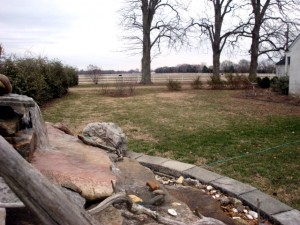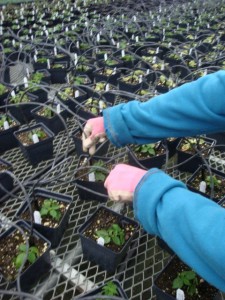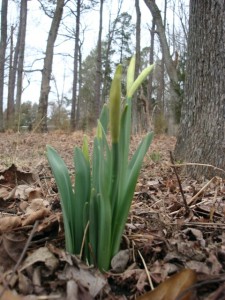by Kenan White | Sep 23, 2010 | Basics, Gardening |
Keeping a journal of what goes on in the garden is a great way to keep a record of past events and how the garden grows. By looking back, one can better remember past weather and compare to how current weather may be affecting plants and more generally why the garden is as it is. As it is now, here in Tidewater, Virginia it is really hot and really dry. We haven’t had a really good rain since sometime in spring. So for me as a gardener there has been little exciting to write about; dragging hoses is not very interesting – I know some people who have had this lawn service richmond va company come out and put an irrigation system in their lawns to help with maintaining the grass, among other things, but we’re determined to do it all ourselves. We have not planted our fall salad patch just because it is too hot and dry for success!
One thing I have done is plant some herb plants in clay pots; diameters are from 6 to 8 inches. These potted herbs are growing on my back step, a place with plenty of morning sun and access to water. The drought has made fall planting an unappealing venture, so gardeners may have to change their seasonal patterns while planting this fall. Normally my fall herbs would be planted in a ground bed, but success does not seem likely because it would be hard to water often.
Even with the dry conditions, the growing season ticks on, getting closer to winter each day. So as any gardener knows, timing is everything. If we want things like fresh herbs in winter, we must plant soon or the growing season will fade. To get plenty of fresh herbs this winter, they must be mostly grown before winter. No amount of lighting or heat can match real sunshine. If your garden is as fried as mine, consider a small collection of potted herb plants, and work around the drought.
by Kenan White | Feb 24, 2010 | A Year in the Life.., Basics, Gardening, Growing |
We have introduced our new garden we plan to grow in our cold frame beds and containers. In this garden we hope to recreate situations many home gardeners face. Limited space is our main focus and we will grow annual plants and various herb plants in combination to get the most out of a small space. This is an exciting venture for The Growers Exchange and we can already imagine the beds full of flowering annuals and all of our herb plants inter-planted. Vines will grow on trellises and melons will hang from the rafters. Will spring ever get here?
The other side of “ A Year in the Life of a Garden” theme is the outdoor garden surrounding the nursery office. A hedge was planted and a waterfall was built. As soon as the ground dries enough the beds will be cut out of the grass. Paths will be mulched and when the weather cooperates, plants will be planted. Here we plan to grow every plant we offer. By growing a test garden, we will be better able to know the ins and outs of the plants we sell. New plants will be trialed so we can see how they perform in all seasons. A photo record will be kept and journal entries made to our blog.
Follow the garden as it grows. We hope to begin planting the first seeds this week. Check back here to see the salad garden planted!

by Kenan White | Feb 22, 2010 | Basics, Gardening, Miscellaneous |
Every work place has certain jobs that no one looks forward to doing. But they must be done! One of ours here in the greenhouse is the annual event of putting the little water drip tubes in each pot. That doesn’t sound so bad until the number of drip tubes is considered. Each table has a thousand tubes, eight tables per greenhouse, as you can see it adds up. Broken ones have to be replaced, other than that every one is the same. It takes about a week to complete the task. If this is the kind of work you’d love to do in your greenhouse, you may want to opt for a dwarf wall greenhouse that would look amazing in your back garden.
The good news is that once the drip tube is inserted in the soil, we can feed and water that whole table with a switch. Uniform water in each pot is very important and impossible with hose watering. Once the spring crop is done, we will not face that many at once again until next year. The most important thing about the drip tubes is that they free us up to spend hands on time with the plants, not just watering all day. These little plants will be sent to zone 9-11 gardeners in just a few weeks. Plan your garden now while there is plenty of time, your plants can be ordered for the frost free date in your area.

by Briscoe White | Feb 19, 2010 | Basics, Exploring, Gardening, Inspiration |
I have been confident that sooner or later I would find a sign that this long cold winter would end one day. I was expecting a crocus or a snowdrop, but it was daffodils I spotted first. This is the season bulbs really pull their weight. It will be months before annual plants can face the weather, but here these bulbs have begun their blooming process. It may be a couple of weeks before the blooms actually open, but on the first warm day they will be ready to pop open. Spring is on the way!!
As exciting as early bulbs are, the real work of the garden is still in the future. Let these daffodils be a sign you will follow. Now is the time to get all spring planting planned and “gardened on paper”. Planning ahead will allow your dream garden to grow into reality this summer. Whether herb gardening or just setting out a few flowering annuals, planning will make a better garden. Get ready now and know what you want to do when spring finally arrives.

by Briscoe White | Feb 5, 2010 | A Year in the Life.., Basics, Gardening |
The third major storm of the winter is with us. It looks like another long weekend of babysitting the greenhouses. They are full of young plants, so someone will be here to make sure they stay warm and safe. Today as the snow flies outside, our greenhouse staff members are busy transplanting young herbs and annuals to their final pots. In a few short weeks these plants will be traveling to gardens far and wide. It is important they not get cold!
Being the one left to keep things running, I plan to use this time to plan my early garden. The beds we have in a cold frame are ready to plant, we are just waiting for warmer temperatures. Maybe after this storm we will sow seeds. But before we plant, we must have a plan. The general idea is to grow the herbs and annuals offered by The Growers Exchange, planted in situations similar to homeowners with limited space. We also intend to grow plenty of good things to eat, including lots of herbs. Whilst snowbound I will map out the details of our plantings. Any ideas would be appreciated, we do hope for a free exchange of ideas for this garden project. But first we must get the greenhouses safely through this storm!

by Briscoe White | Dec 14, 2009 | Basics, Gardening, Growing, Herbs |
I am sure all of you reading this are aware that herbs love sunshine, they do not grow in the shade. It only seems that we are growing our greenhouse herbs in shade due to the absence of sunlight these last few weeks. Beginning with a strong Nor’easter, we have been rained on, washed by flowing torrents, and flooded by tides that get higher as long as the wind blows. The rain gauge has overflowed so many times we lost an accurate count of total inches fallen; but I will hazard 6” the last few weeks. One night last week we did measure 3.5”; water, water everywhere. We keep our Twitter account active with frequent Tweets; one of our contacts in California has been Tweeting about their lack of rain. Too bad we cannot virtually send them some of our excess. Growing herbs during one of these long wet cycles can be very challenging, especially in winter. Most herbs prefer dry, well-drained soil, none like their roots wet for an extended time. Even in the greenhouse, it is hard to keep the herb plants dry enough after days of cloudy weather. It is best to only water herbs in danger is wilting, until the sun returns. Culinary herbs grow well inside if provided adequate sunlight, six hours minimum. During the winter months, herbs such as marjoram, oregano, thyme, and rosemary can be kept as potted plants in a kitchen window, ready for trimming as the cook demands seasoning. To keep your herbs healthy through this long rainy period, keep the soil on the dry side. Winter savory, parsley, and bay are all favorites in the cook’s winter garden, they make very nice potted plants and are ready to join dinner when the cook calls. As soon as the sunshines again, I will give my herbs a big drink of water, with a shot of fish fertilizer to celebrate the return of sunny days.






